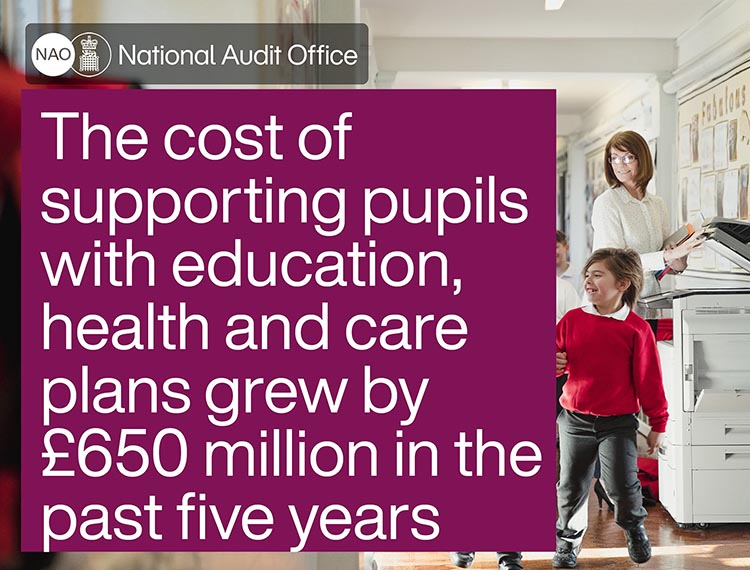New national funding formula has shifted funding from more deprived schools to less deprived schools

@NAOorguk – School funding formula takes from the poor and gives to rich
A report by the National Audit Office (NAO) has found that while government funding per pupil has remained virtually unchanged since 2014, a new national funding formula has contributed to a shift in the balance of funding from more deprived schools to less deprived schools.
The Department for Education’s (the Department’s) total funding for mainstream schools increased from £36.2 billion in 2014-15 to £43.4 billion 2020-21. However, the increase in pupil numbers meant real-terms funding per pupil rose by only 0.4%. The Department plans to increase school funding in 2021-22 and 2022-23, so total and per-pupil funding is expected to rise in real terms by around 4%.
Between 2015-16 and 2019-20, cost pressures on mainstream schools were estimated by the Department to have exceeded funding increases by £2.2 billion, mainly because of rising staff costs. Teaching staff costs increased by an estimated £3.6 billion (17%) during this period because of rises in teachers’ pay costs and higher pension and national insurance costs. The cost of supporting an increased proportion of pupils with education, health and care plans also grew by around £650 million between 2015-16 and 2020-21. Overall, funding increases were projected to exceed cost pressures in 2020-21.
However, the Department did not take account of the potential impact of COVID-19 as part of its assessment of cost pressures. While the Department provided schools with funding during the early stages of the pandemic for exceptional costs, and later in 2020 to help schools cover costs arising from staff absences, several stakeholders told the NAO that this funding would be insufficient. The Department also provided funding for the extra costs of providing free school meals in early 2021, and plans to spend a further £3.1 billion between 2020-21 and 2024-25 to help pupils to catch up on learning lost during the pandemic.
The Department implemented a new national funding formula in 2018-19, which means funding for schools is now allocated more transparently and consistently. It allocates three-quarters of school funding based on pupil numbers, and the remainder is based on factors relating to the characteristics of pupils and schools. Before 2018-19, local authorities received a per-pupil funding rate largely determined by the rate they had received in the previous year. The Department did not calculate funding at school level or explicitly base funding on need, which meant similar schools in different local authorities could receive quite different funding allocations.
As part of the national funding formula, the Department introduced a new minimum per-pupil funding arrangement. In 2020-21, the levels were set at £3,750 per primary pupil and £5,000 per secondary pupil. Under the minimum funding arrangement, 37% of the least deprived fifth of schools were allocated more funding in 2020-21. However, none of the most deprived fifth of schools were allocated an increase in funding as a result of this arrangement. This is because these schools were already receiving per-pupil funding above the new minimum requirement.
Under the national funding formula, more deprived local areas receive more per-pupil funding than less deprived areas as funding is linked to need, but the difference has decreased. The main reasons for the relative re-distribution of funding between local authorities were the introduction of minimum per-pupil funding levels and changes in relative need, such as the proportion of pupils eligible for free school meals.
Between 2017-18 and 2020-21, average per-pupil funding in the most deprived fifth of schools fell in real terms by 1.2%, while per-pupil funding in the least deprived fifth increased by 2.9%. In total, 58.3% of the most deprived fifth of schools saw a real-terms decrease in per-pupil funding.
The Department cannot ensure that that each school receives the funding calculated by the national funding formula or the intended minimum funding levels, since this is decided by local authorities and academy trusts.Local authorities can apply local funding formulae but must pass on minimum per-pupil funding to their maintained schools, while academy trusts do not have to do the same for academy schools. The government has said that it intends to move to a ‘hard’ national funding formula where schools’ budgets would be set directly by the Department based on the formula.
The NAO recommends that the Department evaluates the impact of the national funding formula and minimum funding levels over time. The Department should use this information to review whether it is meeting its objective of allocating funding fairly with resources matched to need, paying particular attention to the shift in the balance of funding away from more deprived schools to less deprived schools.
Sector Reaction
Gareth Davies, the head of the NAO, said:
“The Department for Education has met its objective of making the way it allocates school funding more transparent and consistent. However, it is less clear whether it has met its objective of allocating funding fairly.
“There has been a shift in the balance of funding from more deprived to less deprived local areas. Although more deprived areas and schools continue to receive more per-pupil funding than those that are less deprived, the difference in funding has narrowed. The Department must evaluate whether this funding model is matching resources to need.”
Peter Kyle MP, Labour’s Shadow Schools Minister, said:
“Even before the pandemic, the Conservatives were stripping away funding from the schools and children who need most support. With the gap in learning between kids on free school meals and their peers widening it couldn’t be clearer the Government has got the wrong priorities for school funding.
“The Conservatives are neglecting children, and their ‘feeble’ recovery plans fall far short of what is needed.
“Labour’s Children’s Recovery Plan would deliver the learning and extracurricular opportunities every child needs to bounce back from the pandemic and reach their full potential. It’s time the Conservatives’ match Labour’s ambition for every child.”
UNISON assistant general secretary Jon Richards said:
“Despite promises to level up education funding, the government has acted like Robin Hood in reverse, taking from the poor and giving to the rich.
“The chronic funding gaps that schools face are clear. Any cuts affecting the country’s most vulnerable children are simply going to make existing inequalities even worse.
“This funding formula must be reviewed and overhauled immediately. Money should be allocated based on educational need.”
Jenna Julius, senior economist at the National Foundation for Educational Research (NFER), said:
“We welcome the NAO’s recommendation that the Department should re-evaluate its current approach to ‘levelling-up’ National Funding Formula (NFF) funding.
“We recommend the Government adopts a more progressive approach to NFF funding during this unprecedented time to assist the most deprived schools in providing the extra support needed to help their pupils recover missed curriculum learning.”
Paul Whiteman, general secretary of school leaders’ union NAHT, said:
“This new report from the NAO shows that despite all the spin from government, school funding has effectively remained static since 2014-15. The truth is that, even if these were normal times, schools are still funded inadequately.
“Right now schools face ever-increasing cost pressures as they implement new government policies. And as the NAO rightly identifies, the government has utterly failed to take account of the impact of new cost pressures created by COVID-19.
“The government’s current funding plans are simply insufficient, and the stark reality is that many schools are likely to be forced to make continued cuts at a time when we should be investing heavily in children’s education.
“Time and again government has failed to deliver the funds that schools need for the nation’s young people at this crucial time – the government’s own Covid education recovery advisor resigned, making clear that ten times more funding was needed than government announced.
“The NAO is also right to raise serious questions about the effect of the minimum per-pupil funding arrangement – it is deeply concerning that so many of the most deprived schools have seen a real-terms decrease in per-pupil funding over the last three years. This government has claimed that it believes in ‘levelling up’ opportunities, yet its approach to school funding tells a very different story.
“As the government moves towards its next spending review, it is essential that it prioritises education and invests properly in children and young pupil.”
Kevin Courtney, Joint General Secretary of the National Education Union, said:
“This important report exposes the financial difficulties schools continue to face, even after the start of the Government’s much-heralded funding increase for schools.
“The report also concludes that the Department for Education have ‘not systematically assessed the cost pressures arising from COVID-19’ and that their assurances that schools didn’t have unmanageable costs arising from COVID ran counter to the experience of the stakeholders the NAO spoke to.
“The report questions why local authorities must provide detailed funding information on their maintained schools and yet multi-academy trusts need not publish any information on how they allocate funds or why.
“So yet again the Department for Education have been found out on school funding. Yet again their assurances that schools are in a strong financial position turn out not to be accurate. Yet again the Department’s claims to be prioritising the most disadvantaged turn out to be the opposite of their actions.
“Schools cannot thrive without proper financial support and without a proper assessment of costs. Gavin Williamson pays scant attention to his brief. We hope, however, that both he and the Treasury will heed this report and provide the funding schools and colleges need to allow the nation’s school children to make up for the last year.”
The NAO used the proportion of pupils eligible for free school meals as an indicator of the relative deprivation of local areas and schools.
In January 2020, there were over 20,200 mainstream state schools in England. Around 11,700 of these schools were maintained schools, with 3.8 million pupils, funded and overseen by local authorities. The remaining 8,500 schools (42%) were academies, with 4.4 million pupils. Each academy school is part of an academy trust, directly funded by the Department for Education (the Department) and independent of the relevant local authority.
A report by the Education Policy Institute, Assessing Covid-19 cost pressures on England’s schools, in December 2020 estimated that the Department’s additional funding met 31% of the costs incurred by schools because of the pandemic from March to November 2020. The NAO also consulted the following stakeholders: the Association of Directors of Children’s Services; the Association of School and College Leaders; the County Councils Network; the Institute of School Business Leadership and the Confederation of School Trusts; the Local Government Association; the National Association of Head Teachers; the National Education Union; the National Foundation for Educational Research; NASUWT, The Teachers’ Union; and Parentkind.
The Department provided schools with £139 million for exceptional costs schools incurred in the early stages of the pandemic in 2020, £6 million to cover costs arising from staff absences in November and December 2020 and £50 million for the extra costs that schools incurred in providing free school meals for pupils who were learning at home between January and March 2021. It plans to spend £3.1 billion between to help children and young people catch up on learning 2020-21 and 2024-25.
Alongside the work on school funding, the NAO has been examining the financial health of schools and the support that the Department has provided to schools to help them be more financially sustainable. The NAO plans to report its findings on these issues later in 2021. The NAO reported on the Financial sustainability of schools in 2016.












Responses